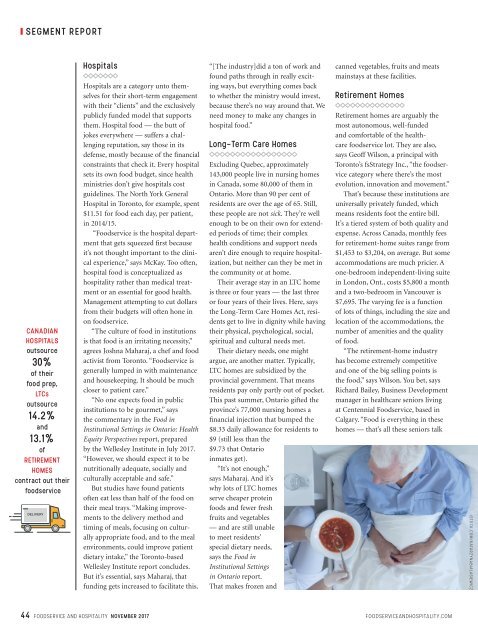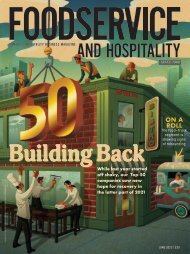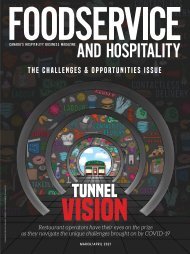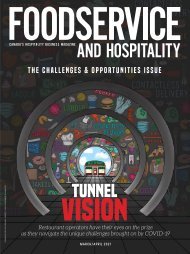FH1117
You also want an ePaper? Increase the reach of your titles
YUMPU automatically turns print PDFs into web optimized ePapers that Google loves.
SEGMENT REPORT<br />
CANADIAN<br />
HOSPITALS<br />
outsource<br />
30%<br />
of their<br />
food prep,<br />
LTCs<br />
outsource<br />
14.2%<br />
and<br />
13.1%<br />
of<br />
RETIREMENT<br />
HOMES<br />
contract out their<br />
foodservice<br />
Hospitals<br />
Hospitals are a category unto themselves<br />
for their short-term engagement<br />
with their “clients” and the exclusively<br />
publicly funded model that supports<br />
them. Hospital food — the butt of<br />
jokes everywhere — suffers a challenging<br />
reputation, say those in its<br />
defense, mostly because of the financial<br />
constraints that check it. Every hospital<br />
sets its own food budget, since health<br />
ministries don’t give hospitals cost<br />
guidelines. The North York General<br />
Hospital in Toronto, for example, spent<br />
$11.51 for food each day, per patient,<br />
in 2014/15.<br />
“Foodservice is the hospital department<br />
that gets squeezed first because<br />
it’s not thought important to the clinical<br />
experience,” says McKay. Too often,<br />
hospital food is conceptualized as<br />
hospitality rather than medical treatment<br />
or an essential for good health.<br />
Management attempting to cut dollars<br />
from their budgets will often hone in<br />
on foodservice.<br />
“The culture of food in institutions<br />
is that food is an irritating necessity,”<br />
agrees Joshna Maharaj, a chef and food<br />
activist from Toronto. “Foodservice is<br />
generally lumped in with maintenance<br />
and housekeeping. It should be much<br />
closer to patient care.”<br />
“No one expects food in public<br />
institutions to be gourmet,” says<br />
the commentary in the Food in<br />
Institutional Settings in Ontario: Health<br />
Equity Perspectives report, prepared<br />
by the Wellesley Institute in July 2017.<br />
“However, we should expect it to be<br />
nutritionally adequate, socially and<br />
culturally acceptable and safe.”<br />
But studies have found patients<br />
often eat less than half of the food on<br />
their meal trays. “Making improvements<br />
to the delivery method and<br />
timing of meals, focusing on culturally<br />
appropriate food, and to the meal<br />
environments, could improve patient<br />
dietary intake,” the Toronto-based<br />
Wellesley Institute report concludes.<br />
But it’s essential, says Maharaj, that<br />
funding gets increased to facilitate this.<br />
“[The industry]did a ton of work and<br />
found paths through in really exciting<br />
ways, but everything comes back<br />
to whether the ministry would invest,<br />
because there’s no way around that. We<br />
need money to make any changes in<br />
hospital food.”<br />
Long-Term Care Homes<br />
Excluding Quebec, approximately<br />
143,000 people live in nursing homes<br />
in Canada, some 80,000 of them in<br />
Ontario. More than 90 per cent of<br />
residents are over the age of 65. Still,<br />
these people are not sick. They’re well<br />
enough to be on their own for extended<br />
periods of time; their complex<br />
health conditions and support needs<br />
aren’t dire enough to require hospitalization,<br />
but neither can they be met in<br />
the community or at home.<br />
Their average stay in an LTC home<br />
is three or four years — the last three<br />
or four years of their lives. Here, says<br />
the Long-Term Care Homes Act, residents<br />
get to live in dignity while having<br />
their physical, psychological, social,<br />
spiritual and cultural needs met.<br />
Their dietary needs, one might<br />
argue, are another matter. Typically,<br />
LTC homes are subsidized by the<br />
provincial government. That means<br />
residents pay only partly out of pocket.<br />
This past summer, Ontario gifted the<br />
province’s 77,000 nursing homes a<br />
financial injection that bumped the<br />
$8.33 daily allowance for residents to<br />
$9 (still less than the<br />
$9.73 that Ontario<br />
inmates get).<br />
“It’s not enough,”<br />
says Maharaj. And it’s<br />
why lots of LTC homes<br />
serve cheaper protein<br />
foods and fewer fresh<br />
fruits and vegetables<br />
— and are still unable<br />
to meet residents’<br />
special dietary needs,<br />
says the Food in<br />
Institutional Settings<br />
in Ontario report.<br />
That makes frozen and<br />
canned vegetables, fruits and meats<br />
mainstays at these facilities.<br />
Retirement Homes<br />
Retirement homes are arguably the<br />
most autonomous, well-funded<br />
and comfortable of the healthcare<br />
foodservice lot. They are also,<br />
says Geoff Wilson, a principal with<br />
Toronto’s fsStrategy Inc., “the foodservice<br />
category where there’s the most<br />
evolution, innovation and movement.”<br />
That’s because these institutions are<br />
universally privately funded, which<br />
means residents foot the entire bill.<br />
It’s a tiered system of both quality and<br />
expense. Across Canada, monthly fees<br />
for retirement-home suites range from<br />
$1,453 to $3,204, on average. But some<br />
accommodations are much pricier. A<br />
one-bedroom independent-living suite<br />
in London, Ont., costs $5,800 a month<br />
and a two-bedroom in Vancouver is<br />
$7,695. The varying fee is a function<br />
of lots of things, including the size and<br />
location of the accommodations, the<br />
number of amenities and the quality<br />
of food.<br />
“The retirement-home industry<br />
has become extremely competitive<br />
and one of the big selling points is<br />
the food,” says Wilson. You bet, says<br />
Richard Bailey, Business Development<br />
manager in healthcare seniors living<br />
at Centennial Foodservice, based in<br />
Calgary. “Food is everything in these<br />
homes — that’s all these seniors talk<br />
iSTOCK.COM/KATARZYNABIALASIEWICZ<br />
44 FOODSERVICE AND HOSPITALITY NOVEMBER 2017 FOODSERVICEANDHOSPITALITY.COM


















